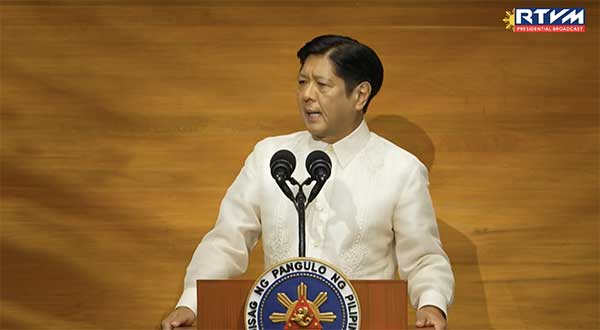
By Rjay Zuriaga Castor and Juliane Judilla
President Ferdinand Marcos Jr. highlighted significant developments in Iloilo’s Jalaur dam and the completion of the major transmission line for Panay Island in his third State of the Nation Address (SONA) on Monday, July 22.
Marcos emphasized the inauguration of the P19.7 billion Jalaur River Multi-Purpose Project Stage II (JRMP II) in Calinog, Central Iloilo, as a testament to the benefits of investing in irrigation projects to spur economic growth.
“Pinatunayan ng proyekto sa Jalaur River ang pinalalawig na potensyal ng irigasyon. Hindi na lamang patubig sa sakahan ang kaya nitong gawin, ito na rin ay magagamit sa pagkontrol ng baha, paglikha ng kuryente at pati na rin para sa turismo,” he said.
The JRMP II is the first flagship project of the National Irrigation Administration (NIA) in Western Visayas and the first large-scale water reservoir outside Luzon.
The JRMP II has three key components: irrigation development, environmental and watershed management, and institutional development.
According to the NIA, the megadam is estimated to increase the region’s annual rice production by 160,000 metric tons, which is almost 20 percent of the region’s annual rice requirement.
NIA added that the project will expand its irrigation service area by 9,500 hectares, covering rain-fed agricultural lands in 17 towns across Iloilo’s four districts.
Apart from irrigation, a portion of the water from the 109-meter Jalaur High Dam’s reservoir, around 86 million liters per day, can be utilized to meet the commercial and industrial bulk water requirements of Iloilo City and its neighboring towns.
The project also has the capacity to produce 6.6 megawatts of hydroelectric power to augment Panay Island’s power supply.
Marcos previously stated that the JRMP II serves as a benchmark and an inspiration for other infrastructure projects due to its scale and magnitude.
As of June 2024, NIA reported that the overall physical accomplishment of the JRMP II is at 75.51 percent, with the remaining civil works focused on constructing the high line canal and the main and lateral canals.
Marcos also mentioned the completion of stage 3 of the Cebu-Negros-Panay (CNP) project, emphasizing that it has prevented prolonged blackouts on Panay Island from April to June this year.
“In the Visayas, all stages of the Cebu-Negros-Panay backbone project have likewise been completed. This project shall serve to stabilize the power situation in Western and Central Visayas, and avert recurrences of power outages experienced in the past,” he said.
The backbone project, which faced delays at least seven times from the original completion date of December 2020, was completed in March this year and energized on April 8.
The project will accommodate the transmission of excess power equivalent to the output of two 400-MW plants from Panay and Negros to Cebu.
“Dahil sa proyektong ito, naiwasan ang blackouts sa Panay Island noong Abril hanggang Hunyo, sa kabila ng yellow at red alerts sa rehiyon,” he added.
The Philippine Rural Electric Cooperatives Association, Inc. reported that Western Visayas is the most affected region by grid disturbances or the red and yellow alerts issued by the National Grid Corporation of the Philippines.
Marcos also emphasized that the government is catching up on routine vaccinations among infants and children in Western Visayas and the Bangsamoro Autonomous Region in Muslim Mindanao (BARMM) as part of the Expanded Program on Immunization (EPI).
“Tuloy-tuloy ang ating paghahabol sa pagbabakuna ng mga sanggol at mga bata lalo na sa Region 6 at BARMM kung saan kulang pa sa kalahati ang nababakunahan,” he said.
The EPI aims to reduce morbidity and mortality among children from the most common vaccine-preventable diseases through inoculations such as BCG birth dose, Hepatitis B birth dose, Oral Poliovirus Vaccine, Pentavalent Vaccine, Measles Containing Vaccines (Antimeasles Vaccine, Measles, Mumps, Rubella), and Tetanus Toxoid.
Data from the Department of Health Western Visayas (DOH-6) showed that at least 61.36 percent of children are fully immunized, below the target of 95 percent.
In 2022, DOH-6 reported 59.52 percent of fully immunized children. Immunization in the region has seen a declining trend since 2020, from 71.02 percent to 65.68 percent in 2021.
As of January this year, the DOH-6 reported that flu vaccination in the region achieved 68.49 percent of the 221,216 vaccines administered from the total allocation of 323,000.
COMPLETE POGO BAN
President Ferdinand Marcos Jr. ordered a ban on Philippine Offshore Gaming Operators (POGOs) during his third State of the Nation Address (SONA) on Monday, July 22.
“Effective today, all POGOs are banned. I hereby instruct Pagcor (Philippine Amusement and Gaming Corporation) to wind down and cease the operations of POGOs by the end of the year,” Marcos said.
”The DOLE (Department of Labor and Employment), in coordination with our economic managers, shall use the time between now and then to find new jobs for our countrymen who will be displaced,” the President added.
The decision was prompted by a series of raids on illegal POGO sites in Pampanga and Tarlac amid allegations of involvement in human trafficking and scam activities.
The Department of Finance (DOF) and the National Economic and Development Authority (NEDA) also supported a full ban, as proposed by some senators.
Meanwhile, PAGCOR Chairman and CEO Alejandro Tengco argued that POGOs need better regulation rather than a full ban to control and prevent such illegal activities.
The ban follows the establishment of a special task force against illegal POGOs by the Philippine National Police (PNP).


















